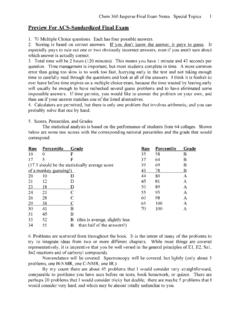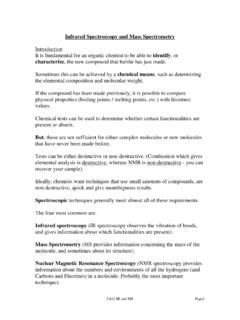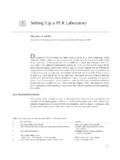Transcription of How genetic engineering differs from conventional breeding ...
1 genetic engineering IS NOT AN EXTENSION OF conventional PLANT breeding ; How genetic engineering differs from conventional breeding , hybridization , wide crosses and horizontal gene transfer by Michael K. Hansen, Research Associate Consumer Policy Institute/Consumers Union January, 2000 genetic engineering is not just an extension of conventional breeding . In fact, it differs profoundly. As a general rule, conventional breeding develops new plant varieties by the process of selection, and seeks to achieve expression of genetic material which is already present within a species. (There are exceptions, which include species hybridization , wide crosses and horizontal gene transfer, but they are limited, and do not change the overall conclusion, as discussed later.)
2 conventional breeding employs processes that occur in nature, such as sexual and asexual reproduction. The product of conventional breeding emphasizes certain characteristics. However these characteristics are not new for the species. The characteristics have been present for millenia within the genetic potential of the species. genetic engineering works primarily through insertion of genetic material, although gene insertion must also be followed up by selection. This insertion process does not occur in nature. A gene gun , a bacterial truck or a chemical or electrical treatment inserts the genetic material into the host plant cell and then, with the help of genetic elements in the construct, this genetic material inserts itself into the chromosomes of the host plant.
3 Engineers must also insert a promoter gene from a virus as part of the package, to make the inserted gene express itself. This process alone, involving a gene gun or a comparable technique, and a promoter, is profoundly different from conventional breeding , even if the primary goal is only to insert genetic material from the same species. But beyond that, the technique permits genetic material to be inserted from unprecedented sources. It is now possible to insert genetic material from species, families and even kingdoms which could not previously be sources of genetic material for a particular species, and even to insert custom-designed genes that do not exist in nature.
4 As a result we can create what can be regarded as synthetic life forms, something which could not be done by conventional breeding . It is interesting to compare this advance to the advances that led to creation of synthetic organic chemicals earlier in the 1900s. One could argue that synthetic chemicals are just an extension of basic chemistry, and in certain senses they are. Yet 2when we began creating new chemicals that had not previously existed on the earth, or which had only been present in small quantities, and began distributing them massively, we discovered that many of these chemicals, even though they were made of the same elements as natural chemicals, had unexpected adverse properties for the environment and health.
5 Because we had not co-evolved with them for millenia, many (though by no means all) had negative effects. Among the serious problems were PCBs and vinyl chloride, which were found to be carcinogens, and numerous organochlorine pesticides, which were found to be carcinogens, reproductive toxins, endocrine disruptors, immune suppressors, etc. After several decades of use, these effects caused such concern that we passed the Toxic Substances Control Act which required premarket screening of synthetic organic chemicals by EPA for such effects as carcinogenicity, mutagenicity and impact on wildlife, and changed our pesticide rules similarly.
6 There are many ways in which these two scientific advances are not analogous, but the experience with synthetic organic chemicals underlines the potential for unexpected results when novel substances are introduced into the biosphere. We will discuss three specific ways in which genetic engineering differs from conventional breeding , and some of the implications for safety, in more detail. The argument is frequently made that genetic engineering is not only an extension of conventional breeding , but is more precise, and therefore safer. We believe that in fact it represents a quantum leap from conventional breeding , is more precise in one way, but more unpredictable in others.
7 We will discuss the following key areas of difference and their implications for unexpected effects: scope of genetic material transferred/unnatural recombination, location of the genetic insertions, and use of vectors designed to move and express genes across species barriers. As a subset of the last category there is the use of foreign promoters ( genetic on switches) and foreign marker genes (particularly genes coding for antibiotic resistance). Finally we will discuss implications for FDA policy. Scope of Gene Transfers As for the scope of genetic material transferred, genetic engineering allows the movement of genetic material from any organism to any other organism.
8 It also offers the ability to create genetic material, and expression products of that material, that have never existed before. This radically differs from traditional breeding , which merely permits the movement of genetic material between different varieties within species, between closely related species, or closely related genera. Even hybridization and wide crosses cannot move genetic material much beyond these limits. The vast bulk of hybrid crops consist of the mating of two genetically pure lines ( lines that are homozygous for all alleles) of the same crop to create a line which is heterozygous. Thus, hybrid corn is simply the crossing of two pure corn varieties to produce a mixed line.
9 Occasionally, though, in conventional breeding , plant breeders will cross a wild relative of a crop (usually a different species within the same genus) in order to transfer particular traits 3from that wild relative (such as resistance to a given disease) to the crop. However, hybrids between two species are also known to occur naturally, although such hybrids are primarily restricted to plants with certain characteristics such as perennial growth habit which most crop plants lack (Ellstrand et al., 1996). Wide crosses, also used by breeders, also occur in nature, but they are rare. When breeders perform wide crosses, they mate two different genera.
10 While the pollen of species A may successfully fertilize the egg of species B, the embryo may not be able to naturally survive and develop into a seedling. The plant breeder, through a technique called embryo rescue, will remove such an embryo from the original hybrid seed and put it into a nutritional environment in the laboratory (one containing various nutrients and plant hormones) and raise it into seedling and adult plant. While such wide crosses are artificial in one sense (the plant wouldn t normally germinate or survive to adulthood), they still represent the mixing of genomes from plants that are fairly closely related and in which fertilization can occur.










